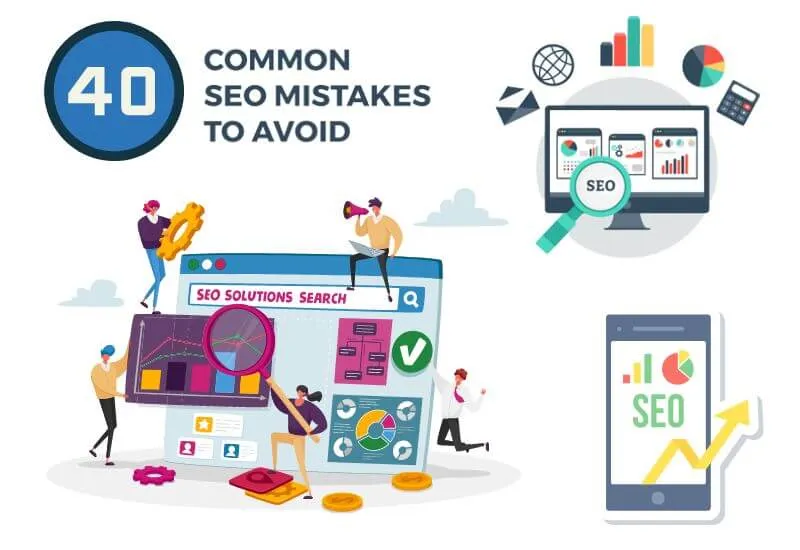40 SEO Mistakes that are easy to avoid in 2024 – Search Engine Optimization ( SEO ) does not fit into a simple phrase: publish high-quality unique content that is referenced by authoritative sources. Behind this concept lies a lot of big and small mistakes that do not allow websites to develop and expand their audience.
We have compiled for you the most complete list of 40 SEO mistakes and tips on how to eliminate them.
Before we get started, it’s important to understand that SEO is a very situational thing. Even if it is believed that low quality links and black hat SEO do not work, you should understand that there are exceptions to the rule.
40 Most Common SEO Mistakes to Avoid in 2024
People are still people who rate their sites solely with automated tools.
But there are always nuances and situations that are difficult to calculate, measure and predict.
#1: Content for cars
Attempts to publish unreadable content for search robots could work 4-5 years ago, but today Google and Yandex algorithms have advanced so much that they can easily distinguish a valuable article from naive manipulation. And they will punish you.
#2: Lack of Consistency
In the current competitive landscape, SEO requires teamwork. Lack of coordination between marketers, SEOs and other company specialists is worth the loss of places in the search results.
#3: Ignoring Webmaster Tools
According to experts, the main SEO mistake is ignoring Search Console and Yandex Webmaster. Yes, the Google Analytics functionality is very useful, but it won’t tell the webmaster about sitemap problems or the lack of indexing of web pages.
#4: Empty Alt Text for Images
Newbies often post photos, graphs, and charts without filling in the Alt text of the images. In this case, search engines have no idea about the content of the object, and sites do not receive additional traffic from images.
#5: Keyword Cannibalization
A less obvious miscalculation that even seasoned SEOs make is keyword cannibalization. If web pages within a site compete with each other, they may lose weight and worsen behavioral factors.
#6: Optimized Social Media Content
Some companies try to promote optimized texts through social networks such as Facebook or Instagram. Search engines do not value social media user-generated content, so time is wasted.
#7: Crane Chase in the Sky
Aspiring e-commerce sites are chasing the industry leaders, missing out on real opportunities. Aiming for mega-popular search queries for young web resources usually ends in a brutal fiasco.
#8: No Meta Descriptions
Ignoring meta-description is also found on large websites. Allegedly, they are not ranking factors, which means there is no need to waste time. While this is technically true, a good meta description helps make pages more relevant to user expectations, increase CTR, and reduce bounce rates.
#9: No Authoritative Outbound Links
Google and Yandex want to know that you link to other sites. Many people focus exclusively on inbound links, missing out on the tremendous potential and credibility of outbound links to authoritative resources.
#10 Keyword Spamming
Over the years, one of the most common SEO mistakes has been overspam – an excess of keywords. Copywriters publish texts with a nausea of 10-15% and are surprised at the low ranking. Keys require caution.
#11: Wrong keywords
It can be very costly (in all respects) to optimize your site for the wrong keywords. Aspiring entrepreneurs are drawn to generic competitive words, missing out on lucrative tailed keywords.
#12: Ignoring Webmaster Guidelines
The major search engines publish sets of recommendations, which are the minimum starting point for precise optimization of your site. If they are not listened to, other tools will not bring success to the project.
No. 13: cooperation with amateurs
Never trust an SEO campaign to dubious firms – it can cost you your reputation. The lack of a reliable portfolio and references, the outsourcing of work to outsiders, a stereotyped approach are bad signs.
#14: Weak Internal Optimization
As you know, ranking factors are divided into internal (on the site) and external (around the resource). Before you start actively link building and searching for reputable partners, you need to focus on internal optimization.
#15: Ignoring Local Search
In e-commerce, local search is new. A tool that helps users around the world find businesses nearby – in front of their home, office or hotel room. To get acquainted with the useful feature on the leading search engines, refer to the Yandex Directory and Google My Business settings.
#16: Marketing doesn’t know what SEO is doing
Foreign marketers are concerned that in many companies the marketing department is not aware of the actions of SEOs. The inconsistency of these two teams hurts the optimization of the site and its commercial effectiveness.
No. 17: ill-conceived mobile version of the site
You probably get more than half of your traffic through mobile devices. Despite this, some companies did not take care of convenient functionality and correct display of the site on a small screen. Be mobile friendly!
No. 18: Inattention to the achievements of competitors
Outline the circle of the main competitors, analyze the optimization of their sites. Try to figure out why their SEO is superior or inferior to your strategy. This is a sine qua non for business survival.
#19: Lack of Quality Inbound Links
With the advent of Google Penguin, HTTPS and AMP, people are increasingly forgetting the importance of inbound links as a ranking factor. Meanwhile, the Yandex citation index and Google PageRank determine your place in the search.
#20: Having irrelevant inbound links
Experts consider one of the worst SEO mistakes to inflate the link mass by adding useless, non-strategic links. Irrelevant links infuriate readers and search engines.
#21: Website Redirect Errors
When moving to a new domain or making radical changes to the structure of a web resource, your first task is to set up the redirect correctly. Otherwise, users and robots will constantly stumble upon 404 errors.
#22: Slow download speed
Optimizing your website loading speed is important for more than just high conversions. To make life easier for your users and crawlers, pay attention to image size, JS, and other heavy site elements.
#23: Too many sections and tags
Despite the overly complex business structure, try to keep the site structure simple and user friendly. It is reasonable to limit yourself to 5-10 relevant sections and 150-200 tags.
#24: Inattention to Detail
When optimizing, it is important to pay attention to details. Some site owners recheck download speed, SSL certificate and broken links every month, but they don’t look at the page titles at all!
Read Also: 7 Best Free SEO Plugins WordPress
How to Improve the SEO of Website with Videos?
7 Ways of Good and Correct Off-Page SEO Optimization
#25: Weak titles
The first mistake young websites make is not paying attention to title tags that appear in big bold letters and lure in visitors. Even if you take the first line, a bad name will not be clicked.
#26: Blind Faith in All-Powerful SEO
Almost every business is looking for an agency that “guarantees” the first positions in the issue. In fact, even Google cannot guarantee any place in the SERP, and optimization only helps.
#27: Gray Link Building Techniques
One client, when we moved on to link building, brushed it off: “Don’t worry, my neighbor promised to get a thousand links inexpensively from a very reliable resource.” For the next 15 minutes, we begged him not to risk an expensive project.
#28: Number of links vs quality
In continuation of the topic: today it is easy to go to a neighbor and get a bunch of low-quality links. The problem is that quality links increase your rankings, while junk links increase your penalty risk.
#29: Lack of focus on web analytics
What is impossible to understand is the neglect of analytics. How can you implement strategies if you don’t control site problems in Google Analytics and Yandex Webmaster reports? Keep your finger on the pulse!
#30: No Content Distribution Plan
Everyone knows that the key to increasing organic traffic is great content. But a young project with a low domain authority has very doubtful chances to break into the top 5, especially for competitive queries. A good content distribution plan will help get your mega-articles to more people and get more links.
#31: Wrong Keyword Targeting
Targeting is a very effective tool. And it’s also big money. By targeting the wrong keywords (wrong user intent), the business will not get the expected return on investment.

#32: Not Enough Content Promotion
Content marketers understand the importance of aggressive content promotion. If you sit and wait for people to find and “recognize” your creative genius, years will pass and the once fresh material will grow into moss.
#33: SEO without thinking about users
Technical optimization will not bring serious long-term success if the website owner does not think about the goals, needs and interests of the user. This applies to the relevance of content, navigation, images – literally everything.
#34: DA over PA
In the fight to improve Domain Authority (DA), some people forget about Page Authority (PA). They heavily accumulate links to the main page for the sake of DA, while content pages and sections die at the same time.
#35: Duplicate title and meta descriptions
Another common SEO mistake is not respecting the uniqueness of the title or meta-description. We saw a corporate site where literally every page title corresponded to the name of the company. This is wrong, because meta tags are supposed to tell humans and machines about the unique, search-relevant content of each page.
#36: No Conversion Keys
For an e-commerce site, conversions (sales) are the purpose of existence. Therefore, make sure that your online store is focused not only on the query “Georgian tangerines”, but also “tangerines price where to buy”.
#37: Content doesn’t match search intent
If you’re targeting the search term “how to chop an onion” – check out what the SERP leaders have to offer first. Lots of illustrations and quality video content. This is exactly what the search intent is.
#38: No Anchor Text in Internal Links
By not using relevant anchor text in your internal links, you are missing out on one of the most valuable SEO opportunities. Even if the link needs a call to action, why not provide it with relevant keywords?
#39: Quantity vs. Quality Content
The slogan “content is king” in some companies received a sad continuation – “the king is dead.” Recently, search engines have started degrading sites for dead content, low CTRs, and high bounce rates. All these are indirect signs that visitors are not happy with the quality of published materials.
#40: SEO Without Research
Skipping keyword research and going intuitive is a very risky decision. You may have the most optimized website on the internet. If no one is looking for your keys, titanic efforts will be useless.


